|
Return to Home
Page
Picture
Archives
Email The Old Ammo Guy |
|
Home of the Old Ammo Guy's Virtual
Cartridge Trading Table
Picture Page
September 2017
Please note: Unless otherwise
indicated, the pictures on this web site are my property, and should not
be used by anyone without crediting the source.
An early .32 S&W box by the US
Cartridge Co....
The
United States Cartridge Company box pictured here is
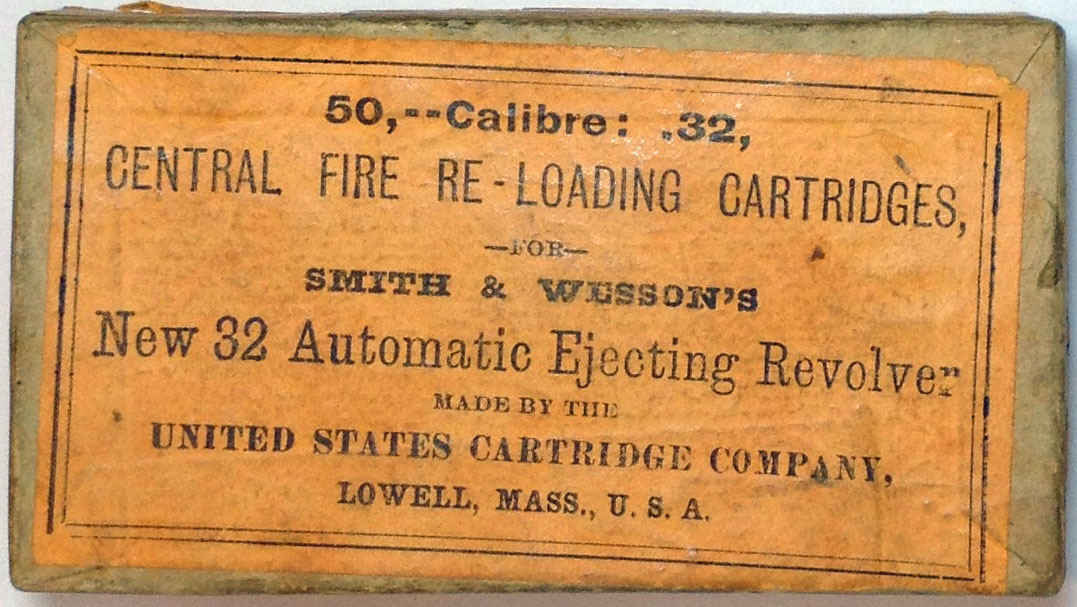 one
of the earlier boxes of .32 Smith & Wesson cartridges produced by this
company. The label indicates that the cartridges are for Smith & Wesson's
New 32 Automatic Ejecting Revolver. This is probably a reference to their Model
No 1 1/2 Single Action revolver, which was introduced in 1878. It could also
refer to Smith & Wesson's .32 Double Action First Model, also one
of the earlier boxes of .32 Smith & Wesson cartridges produced by this
company. The label indicates that the cartridges are for Smith & Wesson's
New 32 Automatic Ejecting Revolver. This is probably a reference to their Model
No 1 1/2 Single Action revolver, which was introduced in 1878. It could also
refer to Smith & Wesson's .32 Double Action First Model, also
 referred
to by
the company as the
New
Model 32 No 1 1/2 Double Action, which was
introduced in 1880. Both the 1 1/2 Single Action and the 1
1/2 Double Action were 'automatic ejecting' referred
to by
the company as the
New
Model 32 No 1 1/2 Double Action, which was
introduced in 1880. Both the 1 1/2 Single Action and the 1
1/2 Double Action were 'automatic ejecting'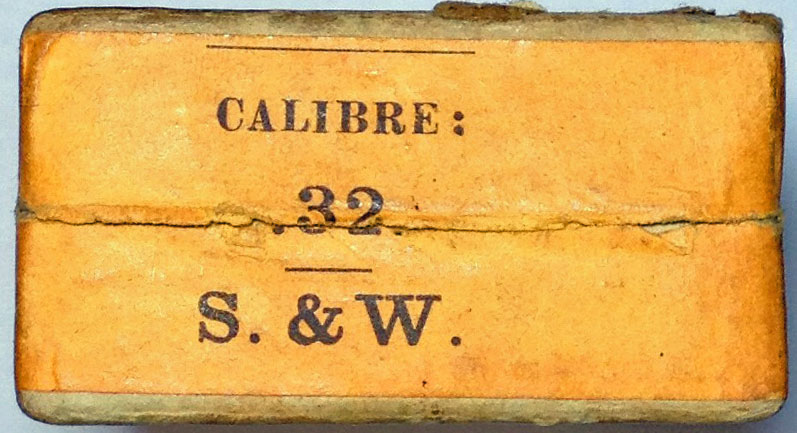 ,
meaning that they automatically extracted the spent cartridge cases upon
opening the revolvers for reloading, but had the company been
referring to their new double action revolver, I believe 'double action'
would have been included in the wording on the label. Up until the
introduction of the 32 caliber No. 1 1/2 Double Action revolver (and the 38
caliber No 2 Double Action revolver) in 1880, all of Smith & Wesson 's
revolvers had been single action and, as such, would not have warranted
including 'Single Action' in the wording on the cartridge box labels. ,
meaning that they automatically extracted the spent cartridge cases upon
opening the revolvers for reloading, but had the company been
referring to their new double action revolver, I believe 'double action'
would have been included in the wording on the label. Up until the
introduction of the 32 caliber No. 1 1/2 Double Action revolver (and the 38
caliber No 2 Double Action revolver) in 1880, all of Smith & Wesson 's
revolvers had been single action and, as such, would not have warranted
including 'Single Action' in the wording on the cartridge box labels.
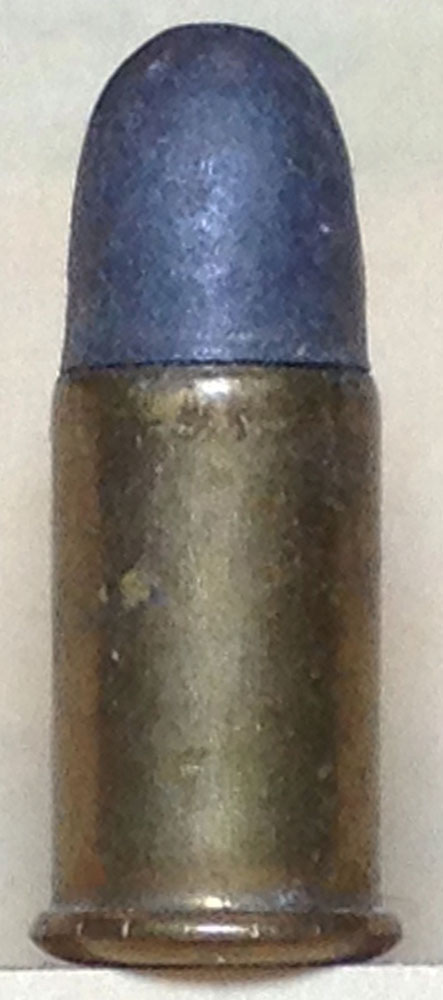 The
cartridges from this box have a smooth belted bullet that has a crimp at the mouth of
the case to hold it securely in place. I've shown the cartridge very much
enlarged to show the very narrow groove that can be seen just above the case
mouth. This groove appears to have been cut into the surface of the bullet
during the case mouth crimping operation. The rounded head of the case is a
characteristic of the early folded head cases that the US Cartridge Company
produced. The sectioned head The
cartridges from this box have a smooth belted bullet that has a crimp at the mouth of
the case to hold it securely in place. I've shown the cartridge very much
enlarged to show the very narrow groove that can be seen just above the case
mouth. This groove appears to have been cut into the surface of the bullet
during the case mouth crimping operation. The rounded head of the case is a
characteristic of the early folded head cases that the US Cartridge Company
produced. The sectioned head
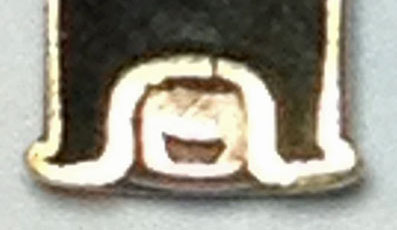 of
one of the cartridges from the box is shown to the right. It's rim was
folded in place as one of the last steps in the case forming process,
similar to the way rim fire cases were (and still are) made. This proved to
be a weak head design for center fire cartridges, and was replaced by a
number of different 'solid head' of
one of the cartridges from the box is shown to the right. It's rim was
folded in place as one of the last steps in the case forming process,
similar to the way rim fire cases were (and still are) made. This proved to
be a weak head design for center fire cartridges, and was replaced by a
number of different 'solid head' 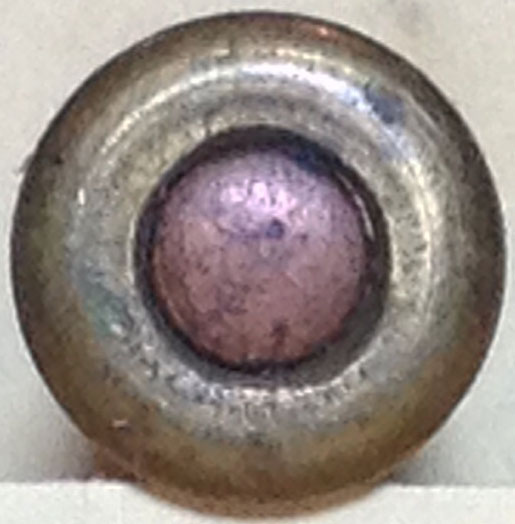 designs
by the various ammunition makers in the mid to late 1880s.
The primer is a rounded version of the Farrington
primer which the company used in one form or another from 1872 until 1926,
when Winchester took over production of ammunition for the US Cartridge
Company. designs
by the various ammunition makers in the mid to late 1880s.
The primer is a rounded version of the Farrington
primer which the company used in one form or another from 1872 until 1926,
when Winchester took over production of ammunition for the US Cartridge
Company.
.
Assuming the 'new'
Smith & Wesson automatic ejecting revolver being referred to
on the label was the single action model, this box was produced between 1878 and
1881, by which time the label would probably have been modified on boxes of
.32 Smith & Wesson cartridges to acknowledge the newly introduced double
action revolver.
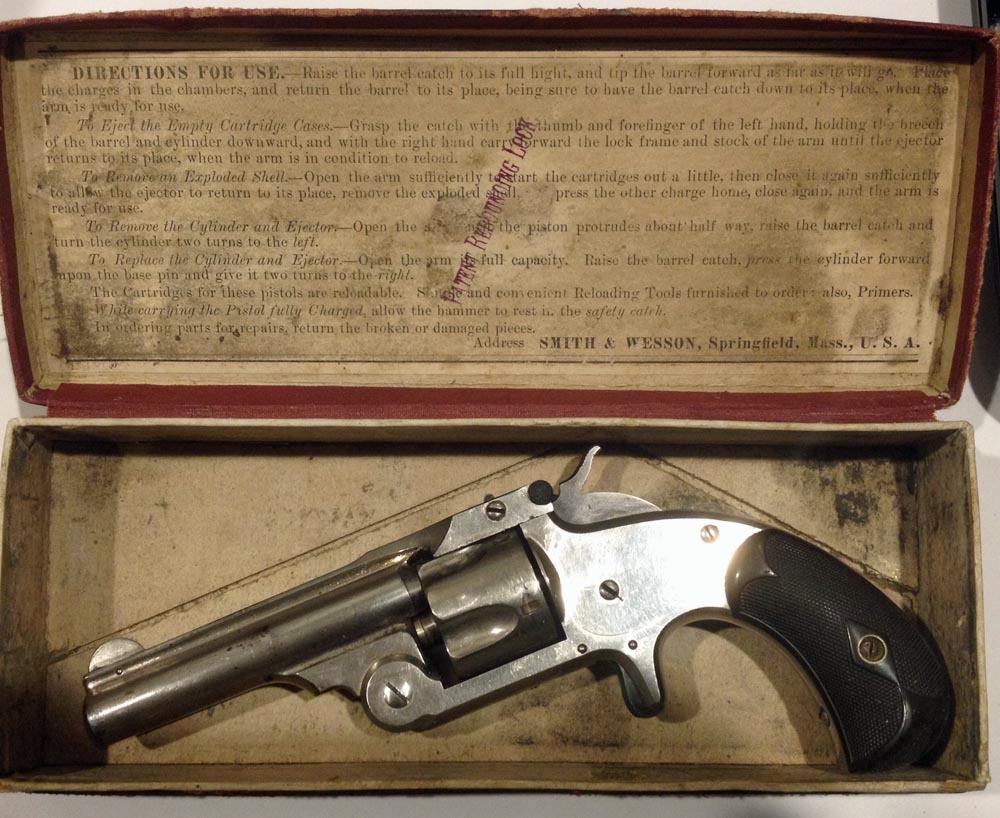 On a related note,
the red cloth covered cardboard box shown here was empty when I found it,
but it originally held a Smith &
Wesson 32 No 1 1/2 Single Action revolver like the one that is pictured in
it. This style box was provided with each revolver when sold new; if
desired, a hinged walnut box could be purchased for an additional 50
cents over the $11 price for the basic blued pistol fitted with hard rubber
grips. The first 100 or so revolvers produced had a safety notch cut in the
hammer to allow the revolver to be safely carried while fully loaded.
Subsequent revolvers were made with a rebounding hammer for which
Smith & Wesson was issued a patent. This rebounding hammer design kept the hammer from
making contact with the cartridge primer
On a related note,
the red cloth covered cardboard box shown here was empty when I found it,
but it originally held a Smith &
Wesson 32 No 1 1/2 Single Action revolver like the one that is pictured in
it. This style box was provided with each revolver when sold new; if
desired, a hinged walnut box could be purchased for an additional 50
cents over the $11 price for the basic blued pistol fitted with hard rubber
grips. The first 100 or so revolvers produced had a safety notch cut in the
hammer to allow the revolver to be safely carried while fully loaded.
Subsequent revolvers were made with a rebounding hammer for which
Smith & Wesson was issued a patent. This rebounding hammer design kept the hammer from
making contact with the cartridge primer
 when
the hammer was at rest; because the safety notch was no longer required, it
was eliminated. The revolver
that was originally in this cardboard box was serial number 2764, as noted
in pencil on the bottom of the box, so it was one that did not have the
safety catch. Note the 'Directions for use' printed in the top of the
box, which include the warning down towards the bottom 'While carrying
the Pistol fully charged, allow the hammer to rest in the safety
catch.' Since these pistols no longer had a safety catch at this point
in production, the company added a red stamped 'PATENT REBOUNDING LOCK' in
the top as a means of advising the purchaser of this revolver of the change. when
the hammer was at rest; because the safety notch was no longer required, it
was eliminated. The revolver
that was originally in this cardboard box was serial number 2764, as noted
in pencil on the bottom of the box, so it was one that did not have the
safety catch. Note the 'Directions for use' printed in the top of the
box, which include the warning down towards the bottom 'While carrying
the Pistol fully charged, allow the hammer to rest in the safety
catch.' Since these pistols no longer had a safety catch at this point
in production, the company added a red stamped 'PATENT REBOUNDING LOCK' in
the top as a means of advising the purchaser of this revolver of the change.
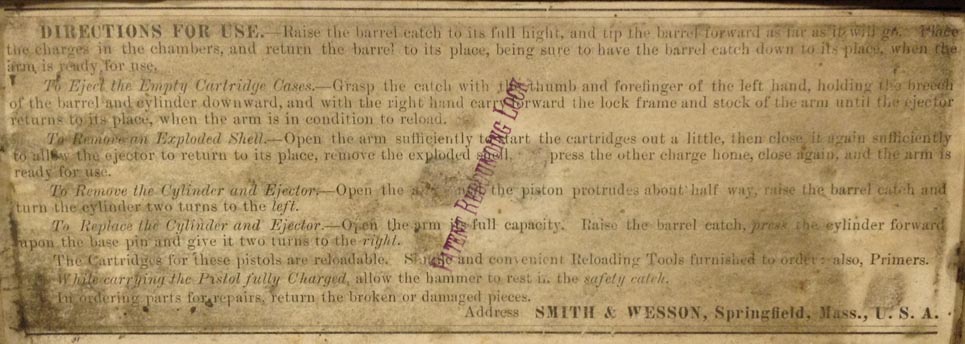
.
.
.
.
.
.
.
.
.
.
.
Sources:
Dates and other information
regarding Smith & Wesson revolver production:
History of Smith & Wesson, Roy G.
Jinks, Bienfield Publishing, 1977
Smith & Wesson 1857 - 1945, A
Handbook for Collectors, Robert J Neal and Roy G Jinks, R&R Books, 1996
Return to Home
Page
.
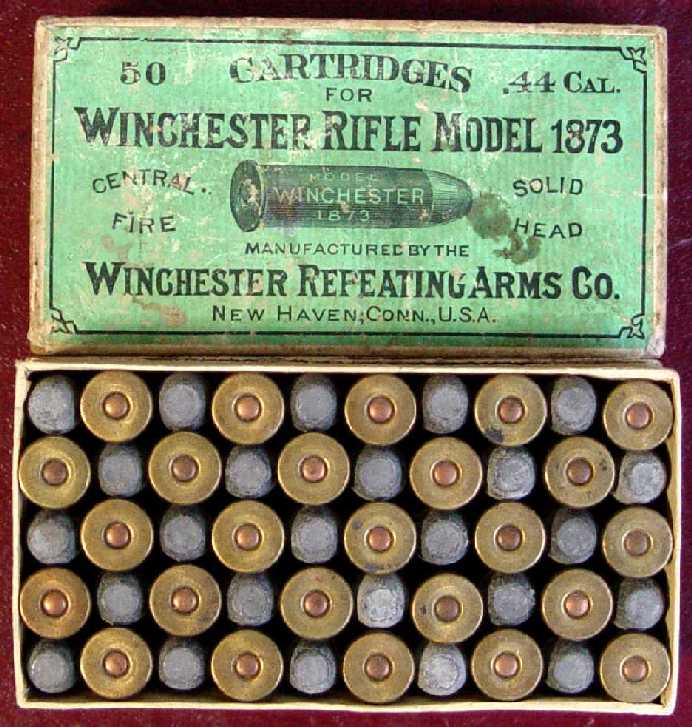
|

 one
of the earlier boxes of .32 Smith & Wesson cartridges produced by this
company. The label indicates that the cartridges are for Smith & Wesson's
New 32 Automatic Ejecting Revolver. This is probably a reference to their Model
No 1 1/2 Single Action revolver, which was introduced in 1878. It could also
refer to Smith & Wesson's .32 Double Action First Model, also
one
of the earlier boxes of .32 Smith & Wesson cartridges produced by this
company. The label indicates that the cartridges are for Smith & Wesson's
New 32 Automatic Ejecting Revolver. This is probably a reference to their Model
No 1 1/2 Single Action revolver, which was introduced in 1878. It could also
refer to Smith & Wesson's .32 Double Action First Model, also
 referred
to by
the company as the
New
Model 32 No 1 1/2 Double Action, which was
introduced in 1880. Both the 1 1/2 Single Action and the 1
1/2 Double Action were 'automatic ejecting'
referred
to by
the company as the
New
Model 32 No 1 1/2 Double Action, which was
introduced in 1880. Both the 1 1/2 Single Action and the 1
1/2 Double Action were 'automatic ejecting' ,
meaning that they automatically extracted the spent cartridge cases upon
opening the revolvers for reloading, but had the company been
referring to their new double action revolver, I believe 'double action'
would have been included in the wording on the label. Up until the
introduction of the 32 caliber No. 1 1/2 Double Action revolver (and the 38
caliber No 2 Double Action revolver) in 1880, all of Smith & Wesson 's
revolvers had been single action and, as such, would not have warranted
including 'Single Action' in the wording on the cartridge box labels.
,
meaning that they automatically extracted the spent cartridge cases upon
opening the revolvers for reloading, but had the company been
referring to their new double action revolver, I believe 'double action'
would have been included in the wording on the label. Up until the
introduction of the 32 caliber No. 1 1/2 Double Action revolver (and the 38
caliber No 2 Double Action revolver) in 1880, all of Smith & Wesson 's
revolvers had been single action and, as such, would not have warranted
including 'Single Action' in the wording on the cartridge box labels.  The
cartridges from this box have a smooth belted bullet that has a crimp at the mouth of
the case to hold it securely in place. I've shown the cartridge very much
enlarged to show the very narrow groove that can be seen just above the case
mouth. This groove appears to have been cut into the surface of the bullet
during the case mouth crimping operation. The rounded head of the case is a
characteristic of the early folded head cases that the US Cartridge Company
produced. The sectioned head
The
cartridges from this box have a smooth belted bullet that has a crimp at the mouth of
the case to hold it securely in place. I've shown the cartridge very much
enlarged to show the very narrow groove that can be seen just above the case
mouth. This groove appears to have been cut into the surface of the bullet
during the case mouth crimping operation. The rounded head of the case is a
characteristic of the early folded head cases that the US Cartridge Company
produced. The sectioned head
 of
one of the cartridges from the box is shown to the right. It's rim was
folded in place as one of the last steps in the case forming process,
similar to the way rim fire cases were (and still are) made. This proved to
be a weak head design for center fire cartridges, and was replaced by a
number of different 'solid head'
of
one of the cartridges from the box is shown to the right. It's rim was
folded in place as one of the last steps in the case forming process,
similar to the way rim fire cases were (and still are) made. This proved to
be a weak head design for center fire cartridges, and was replaced by a
number of different 'solid head'  designs
by the various ammunition makers in the mid to late 1880s.
The primer is a rounded version of the Farrington
primer which the company used in one form or another from 1872 until 1926,
when Winchester took over production of ammunition for the US Cartridge
Company.
designs
by the various ammunition makers in the mid to late 1880s.
The primer is a rounded version of the Farrington
primer which the company used in one form or another from 1872 until 1926,
when Winchester took over production of ammunition for the US Cartridge
Company.  On a related note,
the red cloth covered cardboard box shown here was empty when I found it,
but it originally held a Smith &
Wesson 32 No 1 1/2 Single Action revolver like the one that is pictured in
it. This style box was provided with each revolver when sold new; if
desired, a hinged walnut box could be purchased for an additional 50
cents over the $11 price for the basic blued pistol fitted with hard rubber
grips. The first 100 or so revolvers produced had a safety notch cut in the
hammer to allow the revolver to be safely carried while fully loaded.
Subsequent revolvers were made with a rebounding hammer for which
Smith & Wesson was issued a patent. This rebounding hammer design kept the hammer from
making contact with the cartridge primer
On a related note,
the red cloth covered cardboard box shown here was empty when I found it,
but it originally held a Smith &
Wesson 32 No 1 1/2 Single Action revolver like the one that is pictured in
it. This style box was provided with each revolver when sold new; if
desired, a hinged walnut box could be purchased for an additional 50
cents over the $11 price for the basic blued pistol fitted with hard rubber
grips. The first 100 or so revolvers produced had a safety notch cut in the
hammer to allow the revolver to be safely carried while fully loaded.
Subsequent revolvers were made with a rebounding hammer for which
Smith & Wesson was issued a patent. This rebounding hammer design kept the hammer from
making contact with the cartridge primer
 when
the hammer was at rest; because the safety notch was no longer required, it
was eliminated. The revolver
that was originally in this cardboard box was serial number 2764, as noted
in pencil on the bottom of the box, so it was one that did not have the
safety catch. Note the 'Directions for use' printed in the top of the
box, which include the warning down towards the bottom 'While carrying
the Pistol fully charged, allow the hammer to rest in the safety
catch.' Since these pistols no longer had a safety catch at this point
in production, the company added a red stamped 'PATENT REBOUNDING LOCK' in
the top as a means of advising the purchaser of this revolver of the change.
when
the hammer was at rest; because the safety notch was no longer required, it
was eliminated. The revolver
that was originally in this cardboard box was serial number 2764, as noted
in pencil on the bottom of the box, so it was one that did not have the
safety catch. Note the 'Directions for use' printed in the top of the
box, which include the warning down towards the bottom 'While carrying
the Pistol fully charged, allow the hammer to rest in the safety
catch.' Since these pistols no longer had a safety catch at this point
in production, the company added a red stamped 'PATENT REBOUNDING LOCK' in
the top as a means of advising the purchaser of this revolver of the change. 